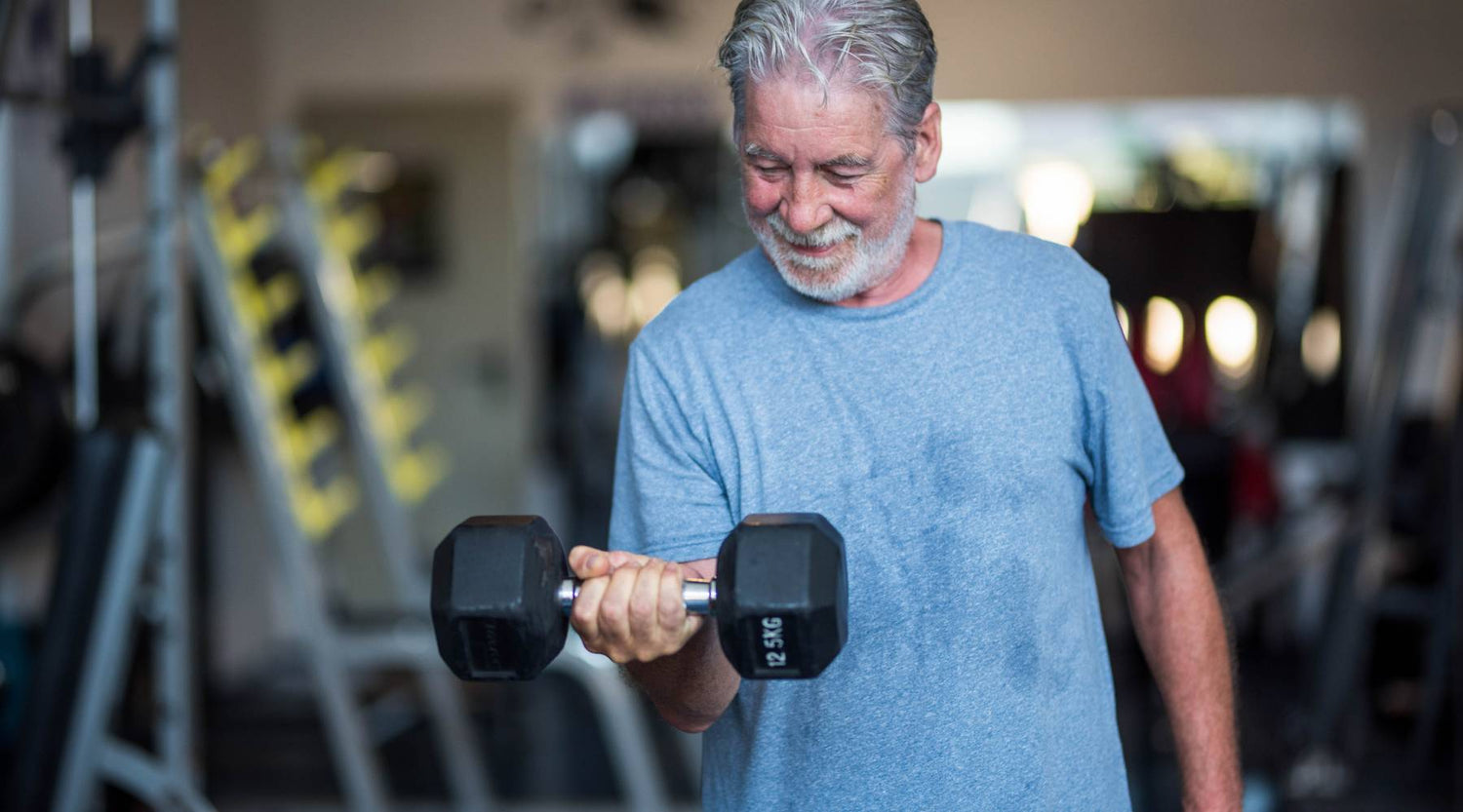In our journey of life, it's never too late to focus on our health and well-being. And for seniors, one powerful way to stay strong and healthy is through strength training. Yes, you heard it right! Strength training is not just for the young and athletic; it's also incredibly beneficial for older adults. In this guide, we'll take a closer look at the importance of strength training for seniors and equip you with all the information you need to get started on this empowering journey.
Main Keypoints
- Importance of Strength Training: Strength training helps seniors maintain muscle strength, improve bone health, enhance balance, and boost metabolism, contributing to overall health and well-being.
- Safety Measures and Precautions: Before starting a strength training regimen, seniors should seek medical clearance, undergo fitness assessments, and use appropriate equipment to ensure safety and effectiveness.
- Creating a Personalized Routine: Identifying individual fitness goals and incorporating a balanced mix of strength, cardiovascular, and flexibility exercises can help seniors achieve optimal health benefits.
Understanding the Importance of Strength Training for Seniors
As we age, our muscles naturally tend to weaken. This can lead to a decrease in overall strength, balance, and mobility, making us more susceptible to falls and injuries. But here's the good news: strength training can help counteract these effects and promote a healthier lifestyle.
Engaging in regular strength training exercises not only benefits physical health but also plays a crucial role in maintaining cognitive function and mental well-being in seniors. Studies have shown that strength training can help improve memory, enhance cognitive abilities, and reduce the risk of developing neurodegenerative diseases such as Alzheimer's.
Read more: Top 10 Aerobic Activities for Seniors to Stay Active and Healthy
Benefits of Strength Training for Older Adults:
- Increased Muscle Strength: Regular strength training exercises can help build and maintain muscle mass, allowing seniors to perform daily activities more easily.
- Improved Bone Health: Strength training stimulates the production of new bone tissue, reducing the risk of osteoporosis and fractures.
- Enhanced Balance and Stability: By strengthening the muscles around the joints, seniors can improve their balance and reduce the likelihood of falls.
- Boosted Metabolism: Building muscle through strength training can increase metabolism, helping seniors maintain a healthy weight and manage chronic conditions like diabetes.

Seniors need to approach strength training with caution and under the guidance of a qualified fitness professional or healthcare provider. Before starting any new exercise regimen, individuals should undergo a comprehensive physical assessment to identify any underlying health issues or limitations that may affect their ability to engage in certain exercises safely.
Now that we've debunked the myths surrounding strength training and aging, let's explore the essential safety measures and precautions seniors should take before diving into their strength training routines.
Preparing for Strength Training: Safety Measures and Precautions
Strength training offers numerous benefits for individuals of all ages, from improving muscle strength and bone density to enhancing overall functional capacity. However, to reap these benefits safely, it is essential to take certain precautions and follow specific guidelines.
One crucial aspect of preparing for strength training is understanding your body's current capabilities and limitations. This self-awareness can help you tailor your workout routine to suit your individual needs, reducing the risk of injury and ensuring steady progress over time.
Medical Clearance and Fitness Assessment
Before starting any new exercise program, it's essential to consult with a healthcare professional, such as a doctor or a physical therapist. They will evaluate your overall health, medical history, and physical capabilities to ensure that strength training is safe and appropriate for you.
Furthermore, a comprehensive fitness assessment can provide valuable insights into your baseline fitness level, helping you set realistic goals and track your progress effectively. This assessment may include measurements of strength, flexibility, cardiovascular endurance, and body composition.
Essential Equipment for Safe Strength Training
When it comes to strength training, the right equipment can make all the difference. Here are a few key items to consider:
- Dumbbells or Resistance Bands: These versatile tools can help you gradually increase your strength without putting excessive strain on your muscles and joints.
- Stability Ball: Incorporating a stability ball into your exercises can improve core stability, balance, and flexibility.
- Chair or Bench: Using a chair or bench provides support during seated exercises and modifications for those with limited mobility.
Read more: 8 Awesome Power Band Exercises You Can Do At Home
Additionally, investing in proper footwear with good arch support and cushioning can enhance stability and reduce the risk of slips or falls during strength training sessions. Remember, safety should always be the top priority when engaging in any form of physical activity.
Creating a Personalized Strength Training Routine
Now that you've taken care of the necessary safety measures, it's time to create a strength training routine tailored to your specific needs and goals.
Strength training is a versatile form of exercise that can be customized to target various muscle groups and achieve different outcomes. Whether you're aiming to build muscle mass, increase endurance, or enhance overall functional strength, designing a personalized routine is key to reaching your fitness goals effectively.
Identifying Your Fitness Goals
Before you start your strength training journey, it's essential to identify what you want to achieve. Whether it's improving overall strength, increasing mobility, or managing a specific condition, understanding your goals will help you stay focused and motivated.
Take the time to assess your current fitness level and pinpoint areas that you want to improve. This self-reflection will not only guide your exercise selection but also enable you to track your progress over time. Setting specific, measurable goals, such as lifting a certain weight or mastering a particular exercise, can provide a clear roadmap for your strength training regimen.

Balancing Strength Training with Other Exercises
While strength training is highly beneficial, it's important to strike a balance by incorporating other types of exercises into your routine. Consider including cardiovascular exercises, such as walking or swimming, to improve heart health and endurance.
Additionally, don't overlook the importance of flexibility and mobility training in conjunction with your strength workouts. Stretching exercises, yoga, or Pilates can help enhance your range of motion, prevent injuries, and promote overall muscle balance. By integrating a well-rounded fitness program that addresses strength, cardiovascular health, and flexibility, you can optimize your physical performance and well-being.
Key Strength Training Exercises for Seniors
Strength training is crucial for seniors to maintain muscle mass, bone density, and overall functional independence. In addition to cardiovascular exercise, incorporating strength training into your fitness routine can help improve balance, reduce the risk of falls, and enhance daily activities. Here are some key upper and lower body exercises specifically tailored for seniors:
Upper Body Strength Training Exercises
Building upper body strength is essential for tasks such as lifting groceries, reaching for items on high shelves, and maintaining good posture. Here are some excellent upper body exercises for seniors:
- Bicep Curls: Hold a dumbbell in each hand and curl your forearms towards your shoulders, engaging your bicep muscles.
- Shoulder Press: Hold dumbbells at shoulder level, then extend your arms upwards, engaging your shoulder muscles.
- Push-Ups: Perform modified push-ups against a wall or a stable surface to strengthen your chest and arm muscles.
It's important to start with light weights and focus on proper form to prevent injury and gradually increase the intensity as your strength improves. Remember to breathe regularly throughout each exercise and listen to your body's cues to avoid overexertion.

Lower Body Strength Training Exercises
Strong leg muscles are essential for mobility, balance, and maintaining an active lifestyle. Don't forget to work on those leg muscles with these lower body exercises:
- Bodyweight Squats: Stand with your feet shoulder-width apart and slowly lower your body into a sitting position, then stand back up, engaging your leg muscles.
- Step-Ups: Place one foot on a sturdy bench or step and raise your body up, then step back down. This exercise targets your quadriceps and glute muscles.
- Lunges: Take a step forward with one leg and lower your body until your front knee is at a 90-degree angle. Alternate legs to work both sides.
Focus on maintaining proper alignment and balance during lower body exercises to prevent strain on your joints and maximize the effectiveness of the workout. Consistency is key when it comes to strength training, so aim to incorporate these exercises into your routine at least two to three times per week for optimal results.
Nutrition and Hydration for Strength Training
As you engage in strength training, it's important to support your body with proper nutrition and hydration. Ensuring that you fuel your body with the right nutrients and maintain adequate hydration levels can significantly impact your performance and recovery.
When it comes to strength training, understanding the role of essential nutrients in muscle growth and recovery is key. Your body requires a sufficient supply of nutrients to repair and build muscle tissue effectively. In addition to protein, which is crucial for muscle repair, other key nutrients play a vital role in supporting your strength training goals.
Essential Nutrients for Muscle Growth and Recovery
During strength training, your body needs an adequate supply of nutrients to repair and build muscle tissue. Here are some key nutrients to focus on:
- Protein: Ensure you're getting enough protein from sources like lean meats, poultry, fish, eggs, or plant-based alternatives like beans and lentils.
- Calcium and Vitamin D: These nutrients are crucial for maintaining bone health. Include dairy products, leafy greens, and fortified foods in your diet.
- Omega-3 Fatty Acids: Found in fatty fish like salmon and trout, as well as chia seeds and walnuts, omega-3s have anti-inflammatory properties and support overall health.
It's important to remember that a well-rounded diet rich in a variety of nutrients is essential for overall health and optimal performance during strength training. Incorporating a colorful array of fruits and vegetables can provide essential vitamins, minerals, and antioxidants that support your body's recovery and immune function.

Importance of Hydration During Exercise
Staying hydrated is essential for optimizing exercise performance and preventing dehydration. Proper hydration helps regulate your body temperature, lubricate your joints, and transport nutrients and oxygen to your cells. Remember to drink water before, during, and after your strength training sessions to maintain optimal hydration levels.
Seniors need to pay close attention to their hydration levels during exercise, as aging can reduce the body's ability to conserve water. Dehydration can lead to decreased exercise performance, muscle cramps, and fatigue, so be proactive in staying hydrated throughout your strength training routine.
Remember, before making any significant dietary changes, it's always best to consult a registered dietitian or nutritionist who can guide you based on your individual health needs.
Safety and Modifications
Safety should always be the top priority, especially when engaging in physical activities. Here are some additional tips to consider:
- Start Slow and Gradually Increase Intensity: Begin with lighter weights and simpler exercises, gradually increasing the challenge as your strength and fitness improve.
- Focus on Proper Form: Performing exercises with proper form minimizes the risk of injury. If needed, seek guidance from a qualified fitness professional.
- Listen to Your Body: Pay attention to any pain or discomfort during exercise. If something doesn't feel right, modify the exercise or stop and consult a healthcare professional.

It's important to also ensure that your workout environment is safe. Make sure your workout space is clear of any obstacles that could cause tripping or falling. If you're working out at home, consider investing in proper flooring or mats to provide cushioning and support for your joints.
Additionally, don't forget to stay hydrated during your workouts. Proper hydration is essential for maintaining optimal performance and preventing dehydration. Keep a water bottle handy and take regular sips throughout your exercise session.
Now that you have all the tools and knowledge, it's time to embark on your strength training journey. Remember, it's never too late to prioritize your health, stay strong, and live life to the fullest!
FAQs
Why is strength training important for seniors?
Strength training helps seniors maintain muscle mass, improve bone density, enhance balance, and reduce the risk of falls, contributing to overall health and functional independence.
What safety measures should seniors take before starting strength training?
Seniors should consult a healthcare professional for medical clearance, undergo a fitness assessment, use appropriate equipment, and start with light weights, gradually increasing intensity.
How often should seniors engage in strength training exercises?
Seniors should aim to incorporate strength training exercises into their routine at least two to three times per week, focusing on proper form and gradually increasing intensity.
What are some key nutrients for seniors involved in strength training?
Seniors should focus on protein for muscle repair, calcium and vitamin D for bone health, and omega-3 fatty acids for overall well-being and reduced inflammation.





